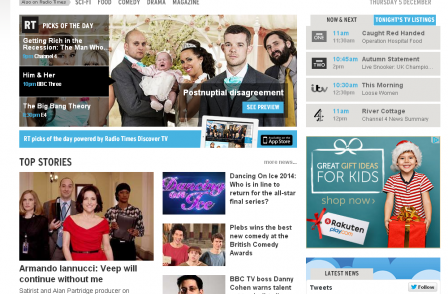
The Radio Times website has more than tripled its website traffic to over 3.5m in the space of three years, with investment in news and features driving the growth.
The title claimed to reach 3.5m unique users in both September and November.
RadioTimes.com editor Tim Glanfield said: “It’s testament to the enduring power of quality content, smart ideas and great journalism, that in Radio Times 90th year we’re growing so fast..”
He said that site moved into profit the first time since its launch in 1997 this year and that its success proves “this is not a time of doom and gloom for journalism, rather the beginning of a new age of content provision for a digital world".
The site claimed to have its busiest ever day on Sunday 24 November, the day after the Doctor Who 50th anniversary, when it attracted 305,409 unique visitors.
The Radio Times was sold by the BBC to Immediate Media in November 2011, and since then the new owner says there has been increased investment in the site, a redesign and a boost in the size of the editorial team.
Glanfield joined the site in January 2011 as news editor. He is one of a trio of journalists who were behind the media blog Beehive City set up in 2010
That site attracted a substantial following, claiming up to 500,000 unique users a month, but failed to turn itself into a sustainable business.
Nonetheless all the journalists involved have done well. Former Times media editor Dan Sabbagh became media editor of The Guardian at the end of 2010 after helping launch Beehive City, and Adam Sherwin now works for The Independent.
The Radio Times website traffic was running at around 1m unique users a month up until 2011, largely driven by the TV and radio listings service.
Glanfield’s remit was to turn it into a more editorially-driven product.
He said that the traffic growth since then has mainly come as a result of the investment which has been made in journalists and editorial content.
Around 10 journalists work purely online. Glanfield said: “What we’ve tried to do is create a place where TV-lovers can come and people generally interested in entertainment.”
The Radio Times homepage now gives prominent coverage to its own TV-based news and interviews.
The website has a snappier and more irreverent style than the magazine, which celebrates its 90th birthday this year. Not all the magazine content appears online, and that which does is repurposed to better fit the digital format and to appeal to a younger audience.
The site is funded purely by advertising, but last month it launched a paid-for app called DiscoverTV. It aims to provide something different from both the website and the magazine and aims to provide users with recommendations to find the best programmes on TV, catch-up and on-demand.
Talking about the future of the Radio Times print edition, Glanfield says: “The magazine is a huge thing read by 2m people every week. The circulation is still around 800,000 and it has more subscribers than any other magazine.
“Digital growth is a way of us talking to a new audience who wouldn’t necessarily have related to the magazine."
Email pged@pressgazette.co.uk to point out mistakes, provide story tips or send in a letter for publication on our "Letters Page" blog
